Christofle French 6 Pc. Tray, Tea & Coffee Set With Samovar
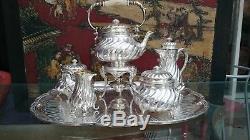
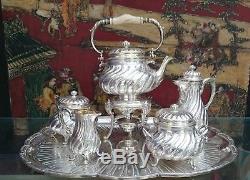
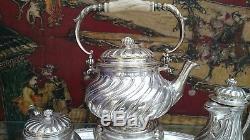
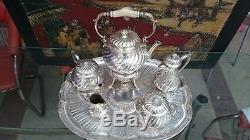
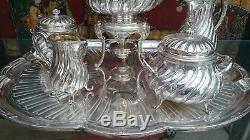

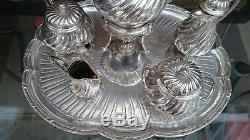
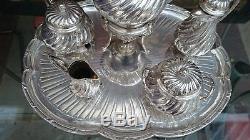
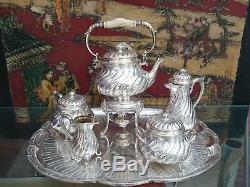
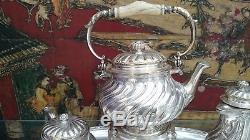
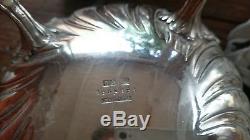
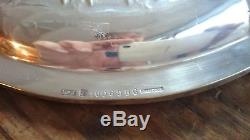

TRAY TEA & COFFEE SET WITH SAMOVAR. The name Christofle evokes both the concept of innovative modern design and the elegance of a bygone era. Today the company, headed by Maurizio Borletti who is the 6th generation of the family, continues their tradition as purveyors of fine design and superior quality cutlery, hollowware, dinnerware, crystal, jewellery and gifts. Thanks to a selective distribution system, Christofle today has become an international luxury brand with a retail distribution network. Christofle Orfevrie was established in 1837 by Charles Christofle.
It has been a continuous innovative force and has infused each era with a new art of living. Over time this prestigious company has revolutionised styles, techniques and methods for the production and distribution of silver plate and the decorative arts. Today, as in the past, whether gracing the tables of emperors, princes or maharajas, in palaces, on board the Trans-Siberian Railway, Orient Express or transatlantic ocean liners or in contemporary restaurants, Christofle continues to make an impression. Christofle cutlery is world famous not only for its quality but also for the comprehensive range of patterns offered (from ultra modern to traditional, encompassing classical and formal styles) that include an extensive range of serving pieces and accessories in silver, sterling and stainless.
Electro plated nickel silver (EPNS) with 33 gms of silver per 1000gms of metal. This process fuses sterling silver onto a nickel silver base by electrolysis. The Christofle EPNS process involves 26 steps with quality control at each step. André Christofle, living in the Marais district of Paris founded his own company manufacturing paillettes and metal strips. Isidore Christofle, silversmith, (brother of André Christofle) registered the first hallmark of master Christofle. Charles Christofle began working as an apprentice to his brother-in-law, Parisian jeweller Hugues Clamette. Charles Christofle took over the jewellery business of Hugues Clamette and from then on he became one of the most important jewellers in France, employing approximately fifty specialised workers.He was backed by his elder sister Rosine, who had married the wealthy French notable Joseph Bouilhet. Christofle began to expand his company, with the old wealth of the Bouilhets to assist him. From the start Christofle looked toward the international arena. Among the company's commissions was the crown for Queen Ranavallo of Madagascar and a series of ceremonial swords produced for customers throughout Latin America.
By the end of his first decade as head of the family firm, Christofle had driven sales to more than FFr 2 million. The death of Joseph Bouilhet left his widow Rosine Christofle-Bouilhet in charge of the family's fortunes. Charles Christofle himself became part of that fortune when Rosine persuaded her daughter to marry her much older uncle.
Rosine Bouilhet's other child, Henri was just seven years old at the time of his father's death and he was to play a still more central role in the development of the family empire. Charles Christofle found himself at the head of a prosperous firm whose work was known not only in France and Europe but also in South America and Madagascar. The company produced jewels, metal fabric, silver filigree, decorations for French army uniforms - the very first pieces known to bear the Christofle stamp were the gilded buttons made to decorate French officers uniforms and special pieces for foreign courts. Charles was a man of taste and a careful observer of advancements in the arts, sciences and technology as well as social developments and he knew that the new bourgeois class agreed with the message of Franois Guizot (then prime minister to King Louis-Phillippe): Frenchmen, enrich yourselves through work and savings! The young Charles Christofle was a visionary captain of industry. He raised significant capital and received financial backing from his brother-in-law, Joseph Bouilhet, a bourgeois member of the Ancien Régime who was then living off a private income. Goldsmiths worked with heated mercury, inevitably inhaling the lethal vapours. One of the very first factories in the world to use electricity was opened.This was a large factory (that was in operation until 1933) on the Rue de Bondy in the République district of Paris facility. This was entirely dedicated to the new plating techniques, placing the whole of the family business's future on the success or failure of this new endeavour. This was a technologically advanced manufacturing plant on an industrial scale and permitted the application of plating of a wider variety of objects than ever before to more common (and less expensive) metals. Now thanks to new electrolysis processes objects are simply dipped in vats.
Connected to the cathode of an electric source, they are coated with molecules from a sheet of precious metal that is connected to the anode and dissolves when subjected to an electric current. This step firmly embarked Christofle on its legendary course as manufacturing silversmiths and Christofle was able to undertake custom work for various silversmiths. At the beginning, however, Christofle preferred to establish a reputation for high quality, limiting his activities to plating works created by other gold and silversmiths. But he found few customers for his plating techniques. Indeed, the company was quickly confronted by a growing number of counterfeit products.
Charles Christofle founded Charles Christofle et Compagnie along with several associates. He stamped all silver plated metal pieces with a hallmark in order to guarantee quality of the silver used for his plated objects and he was compelled to take legal action against numerous rival imitators. Backed by the Bouilhet fortune, Christofle successfully defended his exclusive patent rights before the French tribunals. Christofle had already established the company's silverplating to a far higher percentage (92.5 percent) of silver than his competitors. Meanwhile, unable to find commissions for his plating technique, Christofle decided to launch the family into the production of its own line of products.
Christofle extended his factory's production to include a variety of objects, especially related to table service. In this he seemed to have captured the spirit of the times, as a rising class of French bourgeoisie began to aspire to similar luxuries as the country's fading nobility. The so-called'arts de la table' suddenly became part of the required dining room furnishings.
Christofle offered the new middle class silverware and table service with the same commitment to quality but far less expensive than traditionally crafted sterling silver items. Before long, the Christofle name became something of a generic name for silver-plate.
Christofle became the official provider of table service for King Louis-Philippe and the entire House of Orléans. In 1850, the company received a new and important benefactor when Louis-Napoléon Bonaparte commissioned Christofle to produce a table service for the Palais de l'Elysée. Christofle's relationship with Bonaparte continued after the latter became known as Emperor Napoleon III. Christofle's official titles of'Goldsmith to the King' and the'Emperor's Provider' provided the company with the foundation with which to achieve a new international expansion.
Founding a factory in Karlruhe, Germany, the company began providing such foreign dignitaries as the Kaiser of Germany and the royal households of the Austro-Hungarian Empire, the Ottoman Empire, and the Tsar of Russia. Christofle also proved to have a strong commercial sense.
Hiring a dedicated sales staff, he arranged a number of contracts with retailers worldwide. At this time, Christofle also established the Pavillon Christofle retail store in Paris.Napoleon III ordered a service for the Chateau des Tuileries and Christofle was named silversmith to the king and purveyor to the emperor. Christofle received a prize medal at the 1st Worlds Fair held in London.
This was the first in a very long succession of prizes and awards. Henri Bouilhet, nephew (and brother-in-law) of Charles Christofle, joined the company.
He was a graduate of the École Centrale des Arts et Manufacturers. As an engineer and an artist he perfected the industrial use of the electroplating process. Christofle opened a factory at Karlsruhe, Germany. Emperor Napoleon III appointed Charles Christofle official purveyor to the court. In France a law was passed requiring hallmarks for pieces of silver plate and Jules Garnier discovered one of the worlds largest natural deposits of nickel in New Caledonia.
Charles Christofle died at the age of 58 and the business was taken over by Henri Bouilhet (1830 1910) who expanded the company's business and firmly established the business's industrial approach to luxury goods. This was a departure from the traditional artisan-based industry of the time.
Bouilhet was a shrewd businessman and also an astute engineer. The cousins followed Charless strategy of expansion by opening new markets, introducing new technical developments and expanding the factories. Working with Hermann von Jacobi of St Petersburg Henri invented a new method of plating not just silver and gold but bronze, copper and other metals as well. This new method (called galvanizing) permitted Christofle to begin producing more monumental works. Among the company's most notable productions were the gold-plated bronze winged statues at the Opéra Garnier in Paris, the railroad car for Pope Pius IX, and a 10 metre tall statue for the Notre Dame de la Garde church of Marseilles. The worlds largest electroplated piece was fabricated.It was the statue for the church of Notre-Dame-de-la-Garde. Christofle created the monumental electroplated pieces for the Paris Opera House. Christofle entered into an exclusive agreement with Jules Garnier to use his nickel ore. The same year the Saint-Denis factory was opened. It is still in operation today and is dedicated to the manufacturing of Haute Orfèvrerie (following the example of haute couture).
It also contains a museum devoted to the history of the company. Christofle exhibited an exceptional piece at the Metal Arts Exhibition in Paris. This was the beautiful Art Nouveau coffee pot designed by Heni Carrier-Belleuse called Lúnion fait le succès (success through unity). Christofle received the commission for the renowned Nawab Bed that required, among other things, nearly 640 pounds of solid silver. Christofle outfitted the Orient Express.Christofle opened their showroom at 12 rue Royale in Paris. It remained at that address until 1992 when it moved to 9 rue Royale.
Christofle outfitted the Ritz Hotel and developed a new alloy for their art nouveau line. The Gallia line opened a new market of high quality goods at more affordable prices. Christofle closed the factory at Karlsruhe, Germany and transferred all its manufacturing operations to the factory in Saint-Denis. Two factories were opened - one at Mussoco (Italy) and the other at Pesseux (Switzerland).Gio Ponti created the Fleche (arrow) candelabra whose forms foreshadow 70s design. The company was hit hard by the Depression that helped to wipe out much of its remaining customer base. Combined with management by a series of short-lived family members these were hard times for Christofle.
He was Henri Bouilhet's grandson (and great-grand nephew of the founder, Charles Christofle). Tonys great grandmother was Rosine Bouilhet-Christofle. Christofle was reincorporated as a public limited company, becoming Christofle SA. The Borletti family became major shareholders and important financial backers into the next century. Carla Borletti was not merely a source of new capital for the company, she also proved inspirational in building a new generation of Christofle.She had exceptional taste and used her influence to guide the firm into commissioning designs from some of the most gifted industrial designers, architects and sculptors of the 20th century. At the same time Borletti helped establish a new retail concept for the brand using the Pavillon Christofle name established by Charles Christofle in the mid 1800s.
The company began opening its first foreign branches of the Pavillon Christofle retail chain. The Borletti family's sponsorship enabled Christofle to convince its banks to provide new investment capital. Tony Bouilhet became the head of Christofle.
The classic Cygne (swan) gravy boat was created by Christian Fjerdingstad. This item is still in the collection. Christofle created a 45,000 piece service for the Normandie ocean liner. 1939 to 1945 (The 2nd World War). Machinery was confiscated by the German occupation forces and the silver market collapsed presenting a new interruption to Christofle's growth.
However the great economic expansion of the postwar period helped the company achieve a new scale of international expansion. Tony Bouilhet called upon his son Albert to establish a production and distribution subsidiary in Buenos Aires, Argentina. Other subsidiaries followed in the United States, Italy, Belgium and Germany. Christofle opened a production and distribution subsidiary in Buenos Aires. The company once again succeeded in establishing an international reputation for its high quality, luxury products.
At the same time Christofle maintained its market leadership in France where the company represented more than 50 percent of the market. Henri Bouilhet was named creative director of Christofle. The Bouilhet-Christofle Museum was opened and, with more than 2,000 pieces on display, presented a vast panorama of creations executed by six generations of one family that succeeded each other from 1830 to the present day. The themes evoked illustrate the various silver smith's techniques, the evolution of decorative arts over 170 years and table traditions in the 19th and 20th centuries. The second part presents a panorama of Christofle creations up to World War I: Art Nouveau, the outfitting of luxury hotels and agricultural competitions.
The techniques of the silversmith are displayed as well with explanations and examples of electroplating, cloisonné enamel, guillochage and many more. The archives (including 40,000 documents) are open to the public by appointment. Albert Bouilhet became president of Christofle and his younger brother Marc the Marketing Director. An ultra modern facility is opened in Normandy solely for the purpose of producing flatware. It is capable of producing 5 million pieces of cutlery per year. Company opens production and distribution subsidiary in Brazil. Tony Bouilhet died at the age of 87. Maurizio Borletti at the age of 26 takes over company operations.The Vertigo collection (Andrée Putman) is launched. 1925 of Italy and the Post-Modern work of Roger Tallon b.
1929 and Andrée Putman b. 1927 of France and Gae Aulenti (b 1927) of Italy. Christofle is a French silver firm known to make the best silver plated flatware and serving pieces in the world. Christofle had many commissions by French royalty and aristocracy during the second half of the 19th century during the era of Napoleon III. Their pieces are highly sought after because they are so very heavily plated, unlike plate found anywhere else in the world. They also fitted the dining rooms of the finest hotels and ocean liners in European history. The quality is equal to that of other European companies. I don't accept new users without FEEDBACK. Please check out our other interesting items currently listed.The item "CHRISTOFLE FRENCH 6 PC. TRAY, TEA & COFFEE SET WITH SAMOVAR" is in sale since Monday, June 4, 2018. This item is in the category "Antiques\Silver\Silverplate\Flatware & Silverware". The seller is "prettygold1" and is located in Buenos Aires, Buenos Aires.
This item can be shipped worldwide.
- Age: 1900-1940
- Type: Tea/Coffee Set
- Composition: Silverplate
- Brand: Christofle
- Maker: Christofle

